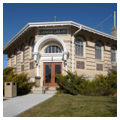You are here
Niobrara County Library
The Niobrara County Library is one of sixteen Carnegie libraries built in Wyoming between 1899 and 1917—a significant number for a state with a very small and dispersed population. The library in Lusk is one of ten in the state standing today, and one of only five that are still used as libraries.
The first library was established in Lusk in 1913, the same year that Niobrara County was formed. The library had several locations over the first few years, until the town’s Civic Improvement Club initiated a campaign to take advantage of the Carnegie Corporation’s program to help communities to build public library buildings. The club launched a subscription drive and raised the funds to purchase the site for the building in 1917. After approving its plans and specifications, Carnegie Corporation awarded the town $11,000 to build the library. A local contractor named Elmer H. Ranck designed the building, following Carnegie Corporation specifications. Early on, the basement of the building was rented for meetings of local clubs and societies; Lusk’s Carnegie library has always functioned as a true community center.
The library occupies a prominent corner in downtown Lusk, and shares the block with the 1919 county courthouse and the 1914 county jail. The Classical-style, hip-roofed building is faced with buff brick with darker brick trim and rests on a raised stone foundation. Although square in shape, the southwest corner of the building is cut off to create an impressive corner entrance. Here, library patrons are welcomed through double doors flanked by pilasters on pedestals supporting a double set of modillion brackets and a full architrave from which springs a shallow, round-arched entry framing a large, round-arched operable transom. A sign reading “CARNEGIE LIBRARY” is placed between the arch and the roof cornice. The open cornice is bracketed. The buff brick walls are accented with rows of dark brown brick every five courses. Each of the four bays of the two primary elevations (west and south) has a single round-arched window in a blind arch that extends from just above the water table to just below the soffit. Window heads are outlined in dark brick arches connected by a belt course at the spring line. Windowsills are stone, and below each window is a decorative panel of dark bricks laid at angles. Between each window arch is a small, diamond-shaped medallion of dark brick. The north elevation matches those of the west and south, but with five bays. A small addition to the east mimics the decorative features of the original library building.
References
Dalgarno, Muriel. “History of the Niobrara County Library, Part 1.” Niobrara County Library. Accessed May 5, 2015. http://www.niobraracountylibrary.org/history/index.php?id=6.
Writing Credits
If SAH Archipedia has been useful to you, please consider supporting it.
SAH Archipedia tells the story of the United States through its buildings, landscapes, and cities. This freely available resource empowers the public with authoritative knowledge that deepens their understanding and appreciation of the built environment. But the Society of Architectural Historians, which created SAH Archipedia with University of Virginia Press, needs your support to maintain the high-caliber research, writing, photography, cartography, editing, design, and programming that make SAH Archipedia a trusted online resource available to all who value the history of place, heritage tourism, and learning.






